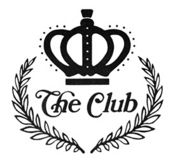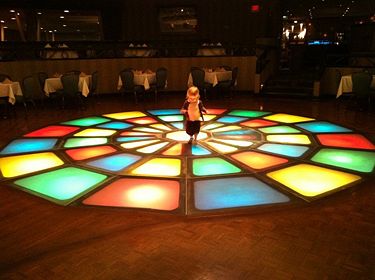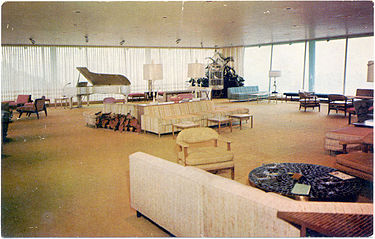The Club
The Club, THE CLUB, or the Club atop Red Mountain, is a notable private supper club which opened on June 12, 1951 on the site of the former Valley View Mine on the crest of Red Mountain.
Beginnings
The Club was the brainchild of Robert S. "Bob" Smith, who wanted to create a world-class supper club in Birmingham. It was founded during the mid 1940s as memberships and stock certificates were sold in anticipation of beginning construction as soon as World War II-related restrictions were lifted. Though he had explored the idea of building on the crest of Red Mountain, the first site to receive serious consideration was at the cloverleaf, the intersection of Montgomery Highway and Lakeshore Drive at Edgewood Lake near the Hollywood Country Club.
After 1000 members were signed up and $150,000 in stock had been issued, architect John E. Davis, Jr of Warren, Knight & Davis was hired to develop conceptual plans for "the finest club in America". The business was incorporated on January 2, 1947 and the property at the cloverleaf was transferred to it the following month. Before construction began, however, Homewood adopted a zoning ordinance placing the property into a residential classification. Negotiations with the city required The Club to purchase additional property as a buffer strip while limiting its own building to the area nearest the highway. Davis, meanwhile, convinced Smith to reconsider the idea of building on the crest of the mountain in order to take advantage of scenic views. The board approved the change, and the land was purchased on June 17, 1948.
Design
Davis' design, one of his first large commissions, took full advantage of the views from the site and incorporated circles and curves freely for aesthetic effect. The entrance doors feature "The Club" in chrome-plated steel. The lobby was done in black and red with custom-made red sofas and hand-woven window blinds. Zodiacal signs were inlaid into the terrazzo floors. The bar and lounge utilized sunset colors of dark pink, olive green, purple and sulphur yellow with a turquoise ceiling.
The main dining room carried the same scheme, accented with purple upholstered banquettes, lime-green tablecloths and turquoise chinaware. The room is arranged in a broad circle with a stage at one end and an illuminated dance floor in the center which could be raised to serve as a second stage area. The feature was a direct inspiration for the lighted dance floor in John Badham's 1977 film Saturday Night Fever. An in-house television booth accommodated live broadcasts. Because of the site's former use as an ore mine, structural columns for the building had to be sunk through the mine's chambers into bedrock below. Water from below-ground pools was utilized in the air-conditioning system.
The private dining room featured red carpeting, hand-painted wallpaper with a calladium leaf design, and a mirrored wall. The rest of the building was taken up by a large kitchen, restrooms, cloak rooms and a small office. Generous outdoor terraces overlooking Jones Valley provided additional seating and dancing areas.
Designer Georgia Schmidt selected the interior finishes and furniture. She chose bold colors and custom-woven fabrics with metallic threads to mirror the bold siting and design of the building. The window shades were woven by Dorothy Liebert. The total cost of construction and furnishing reached $650,000, more than double the original estimates. The doors opened for a members' preview on May 19, 1951.
In a desperate bid to avoid bankruptcy, the new club was re-organized on November 27, 1951 as a non-profit under the guidance of attorney Irvine C. Porter. The club's services to members included nightly dinner seatings (prepared by executive chef John Balazs), bar service at "all legal hours", an orchestra and floor show on weekends, and accommodation of private events. Annual dues were not originally charged.
Most press reviews of the new facility were glowing. Favorable mentions were made in Holiday magazine and the Pittsburgh Press, as well as in local publications. The National Architect published a long feature article on the Club's design in August 1951. A 1953 editorial by Grover Hall Jr, was not as complimentary. He considered the modern design and the unusual name to be indicative of Birmingham's "new money" culture. He famously denigrated the young institution as "Vulcan's platinum honky-tonk.". Birmingham Post-Herald columnist John Temple Graves responded by calling Hall's characterization "amazingly spiteful, provincial and severe."
Expansion
In 1957 a men's club room called the "Gold Room" and a Ladies card room were added to The Club's facilities. In 1966 the kitchen was expanded and a "Men's Grill" and "Inn Room" joined the slate of public areas available to members. During the 1950s and 60's The Club not only hosted premiere orchestras like Tommy Dorsey's and Woody Herman's Thundering Herd, and the Guy Lombardo Orchestra, but also sponsored special events such as art exhibits, fashion shows, and chartered buses to Legion Field for football games.
In 1978 another new addition was built to the north, providing nine new "State Rooms" for dining, some divided by "disappearing walls" which could retract into the floor. The new rooms were furnished by designer Alan Ferry who made use of antiques to create a more "stately" atmosphere than the original modern spaces provided. The project also provided new terraces and additional parking accessed by a new roadway connecting to Valley Avenue. The older access, from Valley View Drive was subsequently closed-off. When Smith retired in 1979 the new access road was named Robert S. Smith Drive in his honor.
Despite the major addition, demand for The Club's rooms still greatly exceeded supply, and planning began for a new "Grand Ballroom", which was completed on a "fast track" and debuted on New Year's Eve, 1985 with 1,362 guests dancing to the sounds of the Joe Giattina Orchestra. The ballroom can accommodate 1,000 diners, 2,000 at receptions, and 600 for performances utilizing the stage and dance floor. Two chandeliers from the original Tutwiler Hotel adorn the 25-foot ceiling. New dressing rooms and a second, dedicated kitchen were added, as well as escalator access to the lower-level lobby which adjoins the new 400-space parking deck.
Bandleader Frank Bettencourt, former conductor for the Jan Garber Orchestra, led his own band in a series of farewell performances at The Club before he retired in 2005 at the age of 90.
Current plans
In 2006 the club's board of directors hired the McMahon Group of St Louis, Missouri to plan a multi-million dollar renovation project aimed at upgrading and expanding its facilities for members. The general membership only became aware of the project after the fact and some objected to having been kept in the dark. A group of members, calling themselves "Concerned Members of The Club", launched an unsuccessful and public campaign to put four of their group on the board. The new board pledged to work more closely with the membership in proceeding with the changes. Plans include patio seating on the terrace, interior renovations, new electronic equipment for conferences, and possibly expanding onto the former site of Baby Doe's Matchless Mine, which the Club has purchased.
A second phase of renovations was completed in late 2018 at a cost of $5.3 million, with significant updates for the Signature Room, the Lounge and the Gold Room, and a new outside terrace bar.
Presidents
- Robert S. Smith (1947–1952)
- Frank Clements (1952–1955)
- William Hoover (1955–1956)
- B. Roper Dial (1956–1959)
- Milton Andrews (1959–1962)
- John E. Davis Jr (1962–1964)
- Warren Whitney (1964–1967)
- Harvey Terrell (1967–1969)
- Edgar Givhan Jr (1969–1971)
- George Mattison Jr (1971–1973)
- Amasa Smith (1973–1976)
- William Spencer III (1976–1978)
- W. W. McTyeire Jr (1978–1980)
- Robert Luckie Jr (1980–1982)
- Kenneth Daniel (1982–1984)
- Ben B. Brown (1984–1986)
References
- "'The Club,' art's dream come true, presents a riotous display of color." (May 20, 1951) The Birmingham News
- Atkins, Leah Rawls (1986) The Club: A History. 1951-1986. Birmingham: The Club, Inc.
- Wolfson, Hannah (January 25, 2007) "Change the Club? Some say it's time." The Birmingham News
- Wolfson, Hannah (January 25, 2008) "Dispute over board elections continues at Birmingham's The Club." The Birmingham News
- Rebman, Stephanie (September 19, 2018) "Major renovation in works at The Club." Birmingham Business Journal
- Rebman, Stephanie (December 3, 2018) "First Look: The Club unveils renovations." Birmingham Business Journal
External links
- The Club website


